Livres/BooksInitiation aux Probabilités et aux chaînes de Markov
 Ce cours, qui s’adresse aux étudiants des universités et des grandes écoles, donne les éléments de la théorie des probabilités utiles à la compréhension des modèles probabilistes de leurs spécialités respectives, ainsi que la pratique du calcul des probabilités nécessaire à l’exploitation de ces modèles.
Ce cours, qui s’adresse aux étudiants des universités et des grandes écoles, donne les éléments de la théorie des probabilités utiles à la compréhension des modèles probabilistes de leurs spécialités respectives, ainsi que la pratique du calcul des probabilités nécessaire à l’exploitation de ces modèles.
Cette initiation aux probabilités comporte trois degrés: le calcul des probabilités, la théorie des probabilités, les chaînes de Markov.
La première partie du cours introduit les notions essentielles: événements, probabilité, variable aléatoire, probabilité conditionnelle, indépendance. L’accent est mis sur les outils de base (fonction génératrice, fonction caractéristique) et le calcul des probabilités (règles de Bayes, changement de variable, calcul sur les matrices de covariance et les vecteurs gaussiens). Un court chapitre est consacré à la notion d’entropie et à sa signification en théorie des communications et en physique statistique. Le seul prérequis pour cette première étape est une connaissance pratique des séries, de l’intégrale de Riemann et de l’algèbre matricielle.
La deuxième partie concerne la théorie des probabilités proprement dite. Elle débute par un résumé motivé des résultats de la théorie de l’intégration de Lebesgue, qui fournit le cadre mathématique de la théorie axiomatique des probabilités et précise les points techniques laissés provisoirement dans l’ombre dans la première partie. Puis vient un chapitre où sont étudiées les différentes notions de convergence, et dans lequel sont présentés les deux sommets de la théorie, la loi forte des grands nombres et le théorème de la limite gaussienne.
Le chapitre final, qui constitue à lui seul la troisième étape de l’initiation, traite des chaînes de Markov, la plus importante classe de processus stochastiques pour les applications. En fin de chaque chapitre se trouve une section d’exercices, la plupart corrigés, sauf ceux marqués d’un astérisque.
Écrit pour : élèves ingenieurs
Livres/BooksMathematical Principles of Signal Processing
Fourier and Wavelets Analysis
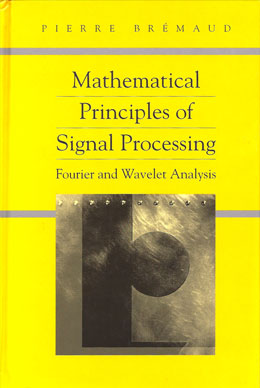 Fourier analysis is one of the most useful tools in many applied sciences. The recent developments of wavelet analylsis indicate that in spite of its long history and well-established applications, the field is still one of active research.
Fourier analysis is one of the most useful tools in many applied sciences. The recent developments of wavelet analylsis indicate that in spite of its long history and well-established applications, the field is still one of active research.
This text bridges the gap between engineering and mathematics, providing a mathematically rigorous introduction of Fourier analysis, wavelet analysis, and related mathematical methods, while emphasizing their uses in signal processing and other applications in communications engineering. The interplay between Fourier series and Fourier transforms is at the heart of signal processing, which is couched most naturally in terms of the Dirac delta function and Lebesgue integrals.
The exposition is organized into four parts. The first is a discussion of one-dimensional Fourier theory, including the classical results on convergence and the Poisson formula. The second part is devoted to the mathematical foundations of signal processing --- sampling, filtering, and digital signal processing. Fourier analysis in Hilbert spaces is the focus of the third part, and the last part provides an introduction to wavelet analysis, time-frequency issues, and multiresolution analysis.
An appendix provides the necessary background on Lebesgue integrals.
Livres/BooksMarkov Chains
Gibbs fields, Monte Carlo Simulation, and Queues
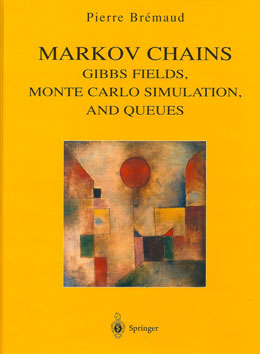 In this book, the author begins with the elementary theory of Markov chains and very progressively brings the reader to the more advanced topics. He gives a usefull review of probability that makes the book self-contained, and provides an appendix with detailed proofs of all the prerequisites from calculus, algebra, and number theory. A number of carefully chosen problems of varying difficulty are proposed at the close of each chapter, and the mathematics are slowly and carefully developed, in order to make self-study easier.
In this book, the author begins with the elementary theory of Markov chains and very progressively brings the reader to the more advanced topics. He gives a usefull review of probability that makes the book self-contained, and provides an appendix with detailed proofs of all the prerequisites from calculus, algebra, and number theory. A number of carefully chosen problems of varying difficulty are proposed at the close of each chapter, and the mathematics are slowly and carefully developed, in order to make self-study easier.
The author treats the classical topics of Markov chain theory, both in discrete time and continuous time, as well as the connected topics such as finite Gibbs fields, nonhomogenenous Markov chains, discrete-time regenerative processes, Monte Carlo simulation, simulated annealing, and queuing theory. The result is an up-to-date textbook on stochastic processes. Students and researchers in operations research and electrical engineering, as well as in physics and biology, will find it very accessible and relevant.
Livres/BooksElements of Queuing Theory
Palm Martingale calculus and Stochastic Recurrences
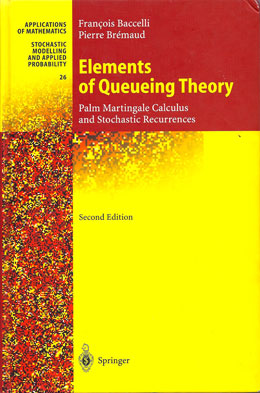 The Palm theory and Loynes theory of stationary systems are the two pillars of the modern approach to queueing. This book, presenting the mathematical foundations of the theory of stationary queueing systems, contains a thorough treatment of both these.
The Palm theory and Loynes theory of stationary systems are the two pillars of the modern approach to queueing. This book, presenting the mathematical foundations of the theory of stationary queueing systems, contains a thorough treatment of both these.
This approach helps to clarify the picture, in that it separates the task of obtaining the key system formulas from that of proving convergence to a stationary state and computing its law.
The theory is constantly illustrated by classical restults and models: Pollaczeck-Khintchin and Tackacs formulas, Jackson and Gordon-Newell networks, multiserver queues, blocking queues, loss systems etc., but also contains recent and significant examples, where the tools developed turn out to be indispensable.
Several other mathematical tools which are useful within this approach are also presented, such as the martingale calculus for point processes,or stochastic ordering for stationary recurrences.
This thoroughly revised second edition contains substantial additions- in particular, exercises and their solutions-rendering this now classic reference suitable for use as a textbook.
Livres/BooksSignal et communication
Modulation, codage et théorie de l'information
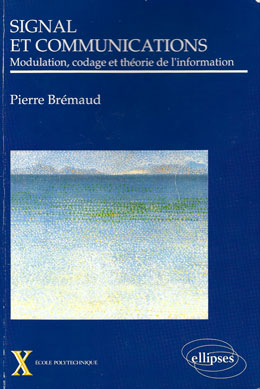 Tout système de communications utilise un canal (faisceau hertzien, câble électrique ou optique, etc.), cause de distorsions variées qu’il faut corriger afin d’assurer la fonction principale d’un tel système : la transmission sans erreur de l’information d’un point à un autre.
Tout système de communications utilise un canal (faisceau hertzien, câble électrique ou optique, etc.), cause de distorsions variées qu’il faut corriger afin d’assurer la fonction principale d’un tel système : la transmission sans erreur de l’information d’un point à un autre.
Pour ce faire, les systèmes de communications numériques transforment l’information qu’ils sont chargés d’acheminer, qu’elle soit sous forme discrète ou analogique, en une suite de symboles binaires (0 et 1). De ce point de vue, le centre du système est une boîte noire dans laquelle entre une suite binaire, et de laquelle sort une suite binaire reproduisant le plus fidèlement possible la suite introduite. C’est cette boîte noire qu’on appelle système de communications digitales, et c’est elle qui est le sujet principal de ce cours.
Les thèmes traités sont : la description statistique des canaux de communications ( en particulier le canal AGB cohérent, le canal AGB non-cohérent, et les canaux à interférence entre symboles), la modulation/démodulation numérique (le MODEM), le codage/décodage numérique( le CODEC), l’évaluation des performances des modems et une introduction à la théorie de l’information (en particulier les théorèmes de Shannon pour le canal binaire symétrique, et pour le canal AGB à puissance et bande limitées).
Livres/BooksSignaux aléatoires
pour le traitement du signal et les communications
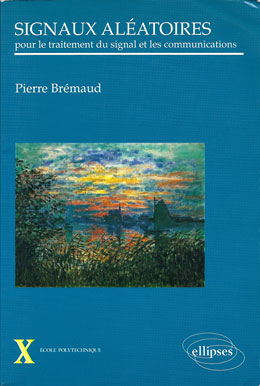 Ce livre donne les éléments de la théorie des signaux aléatoires directement utiles en traitement du signal et en communication numériques. La présentation est rigoureuse,et s’appuie sur les bases mathématiques du cursus de maîtrise de mathématiques ou de première année des Grandes Ecoles d’Ingénieurs ‘intégrale de Lebesgue, calcul des probabilités et espaces de Hilbert. Cependant les thèmes abordés, les exemples choisis et la terminologie employée devraient clairement indiquer qu’il s’agit d’un cours de théorie du signal et non pas d’un cours de mathématiques.
Ce livre donne les éléments de la théorie des signaux aléatoires directement utiles en traitement du signal et en communication numériques. La présentation est rigoureuse,et s’appuie sur les bases mathématiques du cursus de maîtrise de mathématiques ou de première année des Grandes Ecoles d’Ingénieurs ‘intégrale de Lebesgue, calcul des probabilités et espaces de Hilbert. Cependant les thèmes abordés, les exemples choisis et la terminologie employée devraient clairement indiquer qu’il s’agit d’un cours de théorie du signal et non pas d’un cours de mathématiques.
La première partie donne les bases indispensable en théorie des signaux déterministes : transformée en Z, filtrage convolutionnel, théorème d’échantillonnage de Shannon-Nyquist, formule sommatoire de Poisson.
La seconde partie concerne l’analyse de Fourrier des signaux aléatoires stationnaires au sens large : densité spectrale de puissance, effets du filtrage linéaire, bruits blancs, prédiction des modèles ARMA, cumulants et polyspectres, signaux multivariés et leur matrice interspectrale de puissance, signaux passe-bande ou quasi-monochromatiques.
La troisième partie présente les fondement théoriques de l’analyse spectrale paramétriques : algorithme de Levinson, représentation du maximum d’entropie, représentation de Pisarenko.
![]()
Table des matières (pdf-203ko)
Livres/BooksAn Introduction to Probabilistic Modeling
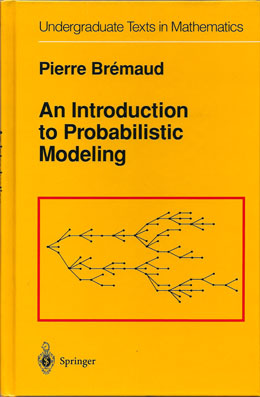 An Introduction to Probabilistic Modeling is a basic introduction at the undergraduate level. It is designed for a one-semester course in which the student is exposed to the basic concepts of independence, expectation, convergence in law, and almost-sure convergence, and learns to carry out computations, especially those concerning Gaussian vectors and Poisson processes.
An Introduction to Probabilistic Modeling is a basic introduction at the undergraduate level. It is designed for a one-semester course in which the student is exposed to the basic concepts of independence, expectation, convergence in law, and almost-sure convergence, and learns to carry out computations, especially those concerning Gaussian vectors and Poisson processes.
The text is complemented by a large number of exercises, each with a detailed solution. In addition, at the end of each chapter are short exposititons of additional,more advanced topics which illustrate the general theory developed in the text. Among them are Stochastic Processes, Bayesian Decision Theory, and Information Theory.
A familiarity with basic calculus and elementary matric algebra is required; however a knowledge of measure theory is not assumed.
Livres/BooksPoint Processes and Queues
Martingale Dynamics
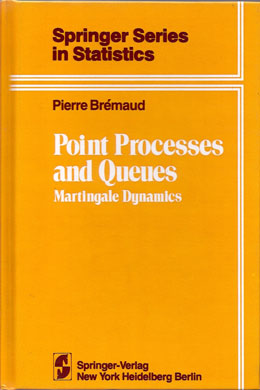 The dynamical aspects of processes on the real line are best captured by the notion of stochastic intensity, which is in turn expressed in terms of martingale.This approach leads to a powerful calculus to be compared to the Ito calculus for Wiener driven stochastic systems.
The dynamical aspects of processes on the real line are best captured by the notion of stochastic intensity, which is in turn expressed in terms of martingale.This approach leads to a powerful calculus to be compared to the Ito calculus for Wiener driven stochastic systems.
This book is an introduction to the subject, with examples of application in queuing filtering and detection, optimal control and information theory.


